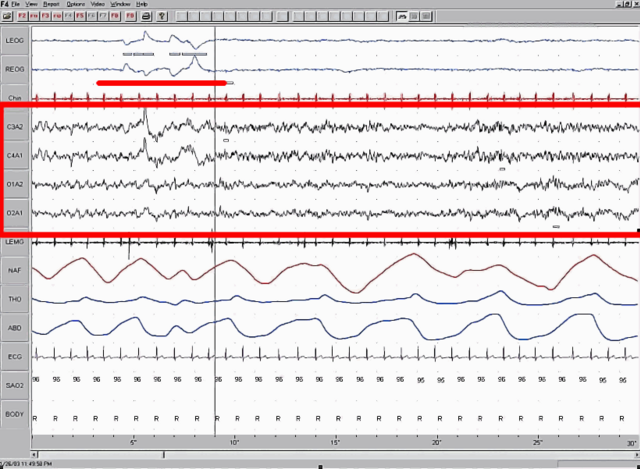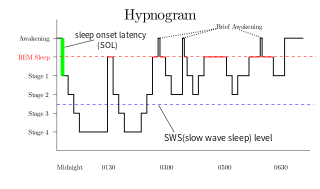热门问题
时间线
聊天
视角
快速動眼期
睡眠过程中周期性出现的以快速眼球运动和骨骼肌张力降低甚至消失为主要特点的状态,常伴有生动梦境 来自维基百科,自由的百科全书
Remove ads
快速動眼期(英語:rapid eye movement,REM)是動物睡眠的一個階段,又稱快速動眼睡眠。在此睡眠階段中,眼球會快速移動,同時身體肌肉放鬆。快速眼動睡眠也被稱作異相睡眠(paradoxical sleep, PS)或者去同步睡眠(desynchronized sleep),因為在這個階段,大腦的神經元的活動與清醒的時候相同,呈現快速、低電壓去同步化的腦電波。控制REM睡眠的電化學活動似乎源於腦幹,其特徵為大量的神經遞質乙酰膽鹼,同時伴隨着單胺類神經遞質,包括組織胺、血清素和去甲腎上腺素的幾乎完全消失。多數在醒來後能夠回憶得栩栩如生的夢都是在REM睡眠發生的。
由於REM睡眠在生理學上與其他睡眠階段極為不同,因此REM以外的睡眠階段被稱為「非REM睡眠」(NREM)。在一個睡眠週期中,REM睡眠和非REM睡眠會交替出現,對於成人來說這個過程大約持續90分鐘。隨着睡眠週期的繼續,REM睡眠所佔的比例逐漸增加。在向REM睡眠過渡期間,會發生顯著的生理變化,首先會出現稱作PGO波的源於腦幹的電脈衝。在REM睡眠期間,機體會偏離平衡態,呼吸、體溫調節和循環系統都會有大幅波動,這樣的情況在其他睡眠相或者清醒時不會出現。身體會突然失去肌肉張力,這個現象被稱為「REM肌肉麻痹」(REM Atonia)。
在1953年,歐根·阿瑟林斯基與納瑟尼爾·克萊特曼發現做夢與REM睡眠之間的聯繫,其後威廉·德門特和米歇爾·朱維特等人作進一步研究。關於REM睡眠,進行過許多類似這樣的實驗:若測試者一進入REM睡眠狀態後就立即被喚醒,會進入一種被稱為「REM睡眠剝奪」的狀態。如果之後測試者獲准正常睡眠,會出現REM睡眠反彈。神經外科、化學注射、腦電圖、正電子發射計算機斷層掃描等技術,以及做夢者醒來的報告,都在研究這個睡眠相的時候得到使用。

Remove ads
生理學上的REM睡眠
REM睡眠是一種「異相的」睡眠,因為它和清醒狀態很相似。雖然身體處於麻痹狀態,但是腦部在某些方面卻很像處於清醒狀態。REM睡眠期間的腦電圖常常會顯示較快、去同步、低振幅的腦電波(神經振盪),與深度睡眠時的Delta波不同,更類似於清醒狀態下的圖樣。[1][2]其中一個很重要的成分,是海馬迴中的θ節律。[3]大腦皮質表現出和清醒時類似的40-60 Hz的γ波。[4]在清醒和異相睡眠期間,腦皮質和丘腦的神經元狀態都會比深度睡眠期間更加去極化,也就是說更容易被激發。在REM睡眠期間,特別是在清醒夢期間,腦的左右半球之間的聯繫會更多。[5]
進入REM睡眠的過程伴隨着PGO(腦橋-膝狀體-枕葉)波,它源於腦幹的電活動激發。[6]在深度睡眠向異相睡眠過渡期間,每6秒鐘就會有一次群發性的PGO波出現,這個狀態會持續1-2分鐘。[2]在到達視覺皮層時,波動的振幅最大,是「快速眼動」的原因之一[7][8]。
通過氧和葡萄糖的代謝來衡量REM睡眠期間腦部消耗的能量,會發現它等於或超過清醒時的能量消耗。與之相比,非睡眠的能耗要低11-40%。[9]
和慢波睡眠相比,異相睡眠和清醒狀態一樣都伴隨着神經遞質乙酰膽鹼的大量利用,會導致較快的腦波。與此同時,單胺類神經遞質,包括組織胺、血清素和去甲腎上腺素則幾乎完全消失。注射乙酰膽鹼酯酶抑制劑可以提高乙酰膽鹼的有效含量,能夠誘使已經進入慢波睡眠狀態的人或動物進入REM睡眠。而在神經元中模擬乙酰膽鹼作用的卡巴膽鹼也可以起到類似的作用。對於清醒狀態下的人來說,只有在單胺類神經遞質耗盡時注射乙酰膽鹼酯酶抑制劑,才會產生異相睡眠。[1][10][11][12][13]
另外兩種神經遞質,食慾素和γ-氨基丁酸,可以增進清醒狀態,抑制異相睡眠,在深度睡眠期間它的量會減少。[1][14]
和腦電活動驟然變化的模式不同,腦中的化學活動表現為連續的週期性擺動。[15]
REM睡眠中的神經活動似乎都是源於腦幹,特別是橋被蓋和藍斑核。根據羅伯特·麥卡利和阿倫·霍布森於1975-1977年提出的活化-整合假說,腦幹中存在着控制REM睡眠的神經元通路「REM開啟」和「REM關閉」。REM開啟神經元是膽鹼能神經元(也就是以乙酰膽鹼為遞質的神經元),而REM關閉神經元會活化血清素與去甲腎上腺素,可以從其他方面抑制REM睡眠。麥卡利和霍布森認為,REM開啟神經元會激發REM關閉神經元,形成REM和非REM睡眠之間的循環機制。[1][10][12][16]他們使用洛特卡-沃爾泰拉方程來描述這樣的拮抗循環關係。[17]Kayuza Sakai和Michel Jouvet於1981年在此基礎上建立了類似的模型。[14]雖然在清醒和REM睡眠期間的皮質都會出現乙酰膽鹼,但是REM睡眠期間,腦幹的乙酰膽鹼的濃度要更高一些。[18]而食慾素和γ-胺基丁酸的減少可能會導致其他興奮型神經遞質的消失。[19]
在1990年代使用正電子發射計算機斷層掃描進行的研究中,證實了腦幹的作用,同時表明前腦中的邊緣系統和旁邊緣皮層,也就是和情緒相關的區域,會比其他區域更活躍。在REM睡眠中激發的區域,和非REM睡眠中激發的區域大致互補。[9]
Remove ads
「快速眼動期」中,大部分的眼球運動其實都比清醒時運動得要慢。它們持續的時間也較短,會更經常地轉一圈之後轉回運動的起點。在REM睡眠期間,每分鐘大約會這樣轉7圈。在慢波睡眠中,兩隻眼球可以分別轉動,但是在異相睡眠中眼球是協同運動的。[20]眼球的運動隨着來自腦幹的PGO波產生。[7][8]眼球運動可能與夢中所見到的視覺景象有關,但是還無法建立它們之間的直接聯繫。也有過這樣的例子,先天盲人的夢中並沒有明顯的視覺圖像,但是在REM睡眠中仍然會有眼球運動。[9]
總的來說,身體在異相睡眠過程中暫停了內穩態。心率、心室壓、心臟輸出、動脈血壓和呼吸率都在進入REM睡眠時迅速地變得不規律。[21]呼吸反射,例如對缺氧的反應一般會減弱。大腦對呼吸的控制減弱:和清醒狀態與非REM睡眠狀態不同,對腦內和呼吸相關的區域進行電刺激,不會對肺部活動產生影響。[22]心率和動脈血壓的波動,表現出和PGO波、快速眼動以及呼吸的顫動或迅速改變同步。[23]
陰莖的勃起(稱作夜間陰莖勃起,簡稱NPT)通常會在人和鼠的REM睡眠階段出現。[24]如果男性在清醒時有勃起功能障礙(ED),但是在REM睡眠期間出現了NPT,則說明他的ED是心理而非生理原因。對於女性來說,陰蒂的勃起(夜間陰蒂勃起,簡稱NCT)導致陰蒂增大,伴隨着陰道充血和分泌液體。通常在一夜的睡眠中,陰莖或者陰蒂勃起的時間在1小時到3.5小時之間。[25]
在REM睡眠期間體溫調節變得紊亂,所以機體對於超出它們的熱中性區(英語:Thermal neutral zone, TNZ)的溫度變得更敏感。貓和其他有毛皮的哺乳類動物在非REM睡眠中會通過顫抖和急促呼吸來調節體溫,但是在REM睡眠中不會。[26]隨着肌肉放鬆,動物失去了通過肌肉運動來調節體溫的能力。(不僅如此,即便是因為腦橋損傷而失去了在REM睡眠期間肌肉麻痹能力的貓,也不會通過顫抖來調節體溫)[27]在非REM睡眠或者清醒狀態時會因為低溫而激活,開啟中性體溫調節機制的神經元,在REM睡眠期間則不會。[28]
正是因為如此,過熱或者過冷的環境也會導致REM睡眠,以及整個睡眠時間的縮短。[29][30]換句話說,如果在深度睡眠相結束時,機體的溫度感應機制監測到溫度超出或者低於熱中性區,就不會進入異相睡眠狀態,以免溫度調節機制的失效會導致體溫超過或者低於應有的範圍。[31]可以通過人工加熱腦部來「騙過」這個機制。[32]
Remove ads
REM肌肉麻痹由運動神經元的抑制引起,會導致身體近乎全面癱瘓狀態。當身體進入REM睡眠時,全身的運動神經元進入超極化狀態,本來為負的膜電位會增加2-10毫伏,相當於提高了激發閾值,需要更強的刺激才能激發它們。肌肉的抑制可能是因為單胺類神經遞質的消失,腦幹中乙酰膽鹼的增加,或者是清醒狀態下的肌肉抑制機制。[33]位於腦橋和脊髓之間的延髓,似乎有能力導致全身的肌肉抑制。[34]但是一些局部的肌肉顫動和反射還是會存在。[35]
REM肌肉麻痹的缺失會導致REM睡眠行為障礙,患者的身體會將他們的夢境表現出來。[36](另一種對二者關係的解釋是,睡眠中的人會「夢到他們身體的動作」,因為發往肌肉的指令先於意識中的圖像。這個解釋也可以適用於正常的睡眠者,他們會試圖控制被抑制的肌肉。)[37](注意通常的夢遊症發生在慢波睡眠期間。)[38]反之,發作性嗜睡病表現為過量、無用的REM肌肉麻痹,也即是清醒時發生的猝倒症狀和白日過度嗜睡,進入慢波睡眠前的臨睡幻覺,或者清醒時的睡眠癱瘓症。[39]包括抑鬱症在內的其他精神疾病,也會導致REM睡眠的佔比變化。[40]罹患睡眠相關症狀的病人,通常會通過多導睡眠圖進行評估。[41][42]
REM睡眠中骨骼肌的運動抑制,膈肌和胸骨旁肌作為呼吸肌維持基本活動[43],且呼吸肌階段性增強,與呼吸頻率及呼吸幅度增加相關 [44]。REM睡眠期間的上呼吸道更僵硬且順應性更低,這種可能差異繼發於REM和NREM之間的上氣道血管灌注差異[45]。
Remove ads
心理學上的REM睡眠
從REM睡眠的發現開始,它就和夢緊密聯繫在一起。喚醒正在經歷REM睡眠的人,是實驗中獲得夢境報告的常用方法;在這個過程中,80%的神經典型者會給出有關夢境的報告。[47]從REM睡眠中醒來的人,給出的夢境報告更加有故事性,並且對於夢中時間的估算也比實際時間更長。[9][48]清醒夢在REM睡眠中要更常見得多[49](事實上它可以被看做REM睡眠和清醒狀態中某些要素的混合狀態)[9]。在REM睡眠期間發生的精神事件也帶有夢的烙印,包括敍事結構、信念(和清醒狀態類似的經驗),以及各種直覺主題的混合。[9]
REM睡眠可以被分為相性的(Phasic)和張性的(Tonic)兩個部分。張性REM依靠腦的theta節律來識別,而相性REM依靠PGO波和較快的眼球運動識別。[50]在相性REM睡眠中,外界的刺激被深度抑制,最近的研究表明睡眠者在相性REM睡眠期間比慢波睡眠期間更難喚醒。[8]麥卡利和霍布森提出,在「相性」REM(phasic REM)睡眠期間的PGO波特性可能會向視覺皮層和前腦提供電刺激,於是產生了夢境中的那些幻視部分。[11][16]然而,比起張性REM睡眠(Tonic REM)中醒來的人,從相性REM睡眠中醒來並不會經歷更古怪的夢境。[48]還有一種可能性,在REM睡眠的這兩個相之中感覺刺激閾值較高的相里,腦會在非現實和古怪的想法中走得更遠。[48]
也有一些夢是出現在非REM睡眠期間。「輕度睡眠者」(light sleepers)在第2階段的非REM睡眠時會做夢,但是「深度睡眠者」(deep sleepers)如果在這個階段醒來,會報告說正在「思考」,而不是在「做夢」。這些試圖解開「夢境為何這樣奇怪」的科學研究,似乎得出的結論是「清醒狀態下的思考就是如此古怪」,特別是在感覺剝奪的條件下。[48][51]因為REM睡眠和夢的聯繫,許多研究者曾經努力地提高它相對於非REM睡眠的重要性。作為神經研究中重要部分的REM睡眠,如果它本身並不導致做夢,那麼整個關於夢的神經生物學可能都需要重新審視自身了。[52]然而,一些異相睡眠的資深研究者(Dement, Hobson, Jouvet)仍然抗拒這些把REM睡眠和做夢分開考慮的嘗試。[9][53]
Remove ads
從REM睡眠中醒來後,腦似乎進入了「超敏感」狀態:更容易接受語義啟動;在易位構詞遊戲和其他創造性的解題遊戲中,從REM睡眠中醒來的人會獲得較好的成績。[54]
REM睡眠會對創造力的發揮產生幫助,將各種碎片元素整合成有用的結果。[55]這個過程在REM睡眠時比非REM睡眠時更有效。[56][57]比起記憶過程本身,創造力的提高更多應該歸功於膽鹼能的和去甲腎上腺素的神經調節。[56]海馬體高水平的乙酰膽鹼會阻止從海馬體到新皮質的反饋,而新皮質較低的乙酰膽鹼和去甲腎上腺素水平,會導致不受控制的相關活動在新皮質區域擴散。與之相反,在意識清醒時,高水平的乙酰膽鹼和去甲腎上腺素會抑制新皮質中的重複聯接。[58]REM睡眠增進創造力的機制是:允許新皮層的結構在層級之間重新組織,使得從海馬體發送來的信息可以根據先前的語義敍述或者印象重新得到解釋。[56]
時間節律

在一個睡眠的「超日節律」(週期短於一日的節律)中,身體經歷了深度睡眠和異相睡眠的交替。而睡眠本身,屬於更大的晝夜節律的一部分,由生物鐘負責調控睡眠和其他的生理指標。睡眠可能分散在一天的不同時間,也可能集中在一段時間:晝行性動物在夜晚睡覺,而夜行性動物在白天睡覺。[59]只要REM睡眠結束之後,身體幾乎立即就恢復了穩態調節。[60]
在一夜的睡眠中,人通常會經歷4-5個REM睡眠時段,一開始的時間較短,後來逐漸增長。一些動物和一些人類在經歷了一段REM睡眠之後的短時間內,會醒來或者經歷非常淺的睡眠狀態。REM睡眠的相對佔比隨年齡變化很大,新生兒的睡眠時間裏超過80%都是REM睡眠。[61]
成年人的REM睡眠時間一般佔總睡眠的20%-25%,也就是每晚90-120分鐘。第一段REM睡眠一般出現在入睡後約70分鐘,之後會緊跟着數個時長約90分鐘的週期,每一個週期中REM睡眠的時間逐漸增加。[15]
嬰兒的REM睡眠時間比成人更長,在童年期間REM睡眠的比例會明顯下降。進入老年之後總的睡眠時間會有所縮短,但是REM睡眠的時間卻相對固定,導致REM睡眠所佔比例相對增加。[62]
REM睡眠剝奪的後果
對REM睡眠的剝奪,會導致嘗試進入REM睡眠的次數顯著增加。在允許恢復REM睡眠的夜晚,進入第三階段睡眠和REM睡眠的速度會加快,並且經歷REM反彈,也就是REM睡眠的時間會比正常情況大幅增加。這些發現一致說明,REM睡眠是生理上的必需。[63][64]
REM睡眠剝奪過後,會發生一些輕度的心理紊亂,例如焦慮、易怒、產生幻覺以及無法集中精力,食慾可能增加。REM睡眠剝奪後,REM睡眠期間的毛細血管RBC流量進一步升高 [65]。REM睡眠剝奪也可能有正面的效果,某些抑鬱症狀可能會因為REM睡眠剝奪而得到緩解;例如攻擊性、食慾可能增加。[64][66]還有分泌過多較的去甲腎上腺素,可能也是以上現象的原因。[10]關於REM睡眠剝奪的時間長度對生理效果的影響,以及這個影響的後果本身都存在爭議。許多報告指出,實驗動物的REM睡眠剝奪導致了攻擊性和性行為的增加。[64]
有研究表明,極端的REM睡眠剝奪,可以改善某些類型的抑鬱症症狀,如果這種抑鬱症是由特定神經遞質失調而引起。雖然睡眠剝奪對於大部分人來說只會造成煩擾,但是它的確被反覆證明可以緩解抑鬱症,雖然效果是暫時的。[67]一半以上經歷了REM剝奪的被試報告說,在下一夜的睡眠之後緩解效果就消失了。研究人員們由此衍生出一些方法,例如在REM睡眠剝奪期之後的一段時間內調整睡眠時間表,[68]並且伴以藥物治療[69]以延長治療效果。雖然大部分的抗抑鬱藥會因為它們對單胺類的作用而選擇性地減少REM睡眠時間,但是在長期使用中這個效果逐漸減弱。睡眠剝奪會刺激海馬迴的神經發生,類似抗抑鬱藥物的作用,但是目前尚不知道這個效果是否僅因為REM睡眠而產生。[70]
對於動物的REM剝奪實驗結果和人類的有些不同。動物的REM睡眠剝奪常常會導致更嚴重的後果。這可能是因為動物的REM睡眠剝奪時間更長(最長達70天),或者是因為動物實驗中的環境比人類實驗要惡劣和痛苦。[66]例如所謂的「花瓶」(flower pot)方法,就是把實驗動物放置在水面的一個平台上,這個平台很小,只要肌肉鬆弛就會掉到水裏。這樣粗暴的喚醒方式可能會引發機體中其他的變化,而不能單純看作是某一相睡眠剝奪的效果。[71]另一種方法是用電腦監測腦電波,一旦實驗動物進入REM睡眠就通過搖晃籠子的方法讓它驚醒。[72]
有證據表明,大鼠的REM剝奪會損壞學習新材料的能力,但是對已經存在的記憶沒有損害。在一個研究中,經歷了REM剝奪的大鼠無法學會避免疼痛刺激,而正常情況下可以學會。在經過一夜REM剝奪之後的人類身上並沒有表現出學習能力的損害。經過REM剝奪的大鼠試圖進入REM睡眠的次數增多,並且表現出REM反彈。在大鼠和貓身上,REM睡眠剝奪會增加腦的興奮度(也就是對感覺信號的放大),也就是降低清醒狀態的發作閾值。在腦的興奮度增加方面,和人體實驗的結果類似。有一項研究還發現了菱腦的興奮度增加。[66]
動物的REM睡眠
REM睡眠存在於所有的陸地哺乳動物和鳥類中。不同的動物有不同的REM睡眠總時間和每一個睡眠週期的時間。捕食者比被捕食者有更長的REM睡眠時間。[10]較大的動物的REM睡眠時間持續較長,可能是因為腦與身體較高的熱容,允許它們在關閉熱調節的狀態下維持更長的時間。[74]一個睡眠週期包括REM睡眠和非REM睡眠,在人類是大約90分鐘,貓是22分鐘,大鼠是12分鐘。[75]
在子宮內的哺乳動物會在REM睡眠中消耗每天一半以上 (50–80%)的時間。[15]
在爬行動物中,只有龜鱉目出現了REM睡眠,他們的快速動眼期在整個睡眠時間中佔到2%,同時伴隨着腦電圖快波。哺乳類和鳥類普遍具有這種現象,REM睡眠每晚的長度與新生兒發育的階段息息相關。舉例來說,鴨嘴獸的新生兒,尚未發育自我生存的能力,一晚有着8小時的REM睡眠;隨着它年齡的增長,每天的REM睡眠逐漸縮短。相反地,海豚等鯨類的新生兒到了近乎發育完成,它們的睡眠中仍然幾乎沒有REM睡眠的發生;隨着它逐漸長大,每天的快速動眼期慢慢出現並增加。
關於REM睡眠功用的理論
關於REM睡眠的功效有數種理論,至今尚未能有定論。
總的來說,睡眠有增進記憶的作用。REM睡眠對鞏固非陳述性記憶、程序記憶和情緒記憶方面很重要。[76]快速眼動期的睡眠的減少不利於鞏固情緒相關的記憶。[77]大鼠的REM睡眠可以增強睡眠之後的強化學習,特別是REM睡眠數小時,有時是幾個晚上之後。在實驗中,REM剝奪有時會阻礙記憶的鞏固,特別是一些較複雜的任務(例如從複雜的迷宮中逃脫)。[78]人類的REM睡眠增進記憶最好的證據,是學習新的身體運動方式(例如在彈床上跳躍),以及新的解決問題技巧。而REM剝奪對於陳述性記憶的損害,只有在類似記憶一個長故事這樣的情況下才會發生。[79]REM睡眠可以明顯地阻止這些記憶的消失。[54]
前人對記憶系統的一種假設模型將記憶分為陳述性記憶與非陳述性記憶。[80]早期的睡眠與記憶的研究就發現,在入睡時的NREM睡眠促進該記憶系統中的回憶任務與再認任務的成績並在記憶任務中增強記憶保留功能。[81]而REM睡眠會促進程序性記憶任務的成績。[82]
根據睡眠和記憶的「雙過程假設」(dual-process hypothesis),睡眠的兩個主要的相,對應兩種不同的記憶。稱為「Night half」的研究對這個假說進行了檢驗:它包括一些記憶任務,有的是在睡覺前開始,在夜半檢驗;也有的是在夜半開始,在早晨檢驗。[83]非REM睡眠中的慢波睡眠,對於陳述性記憶似乎有重要作用。人為延長非REM睡眠,會使得已經記住的一對詞組在第二天更容易回想起來。[84]Tucker等人證明,僅僅包含非REM睡眠的白日小憩會增進陳述性記憶,但是不會增進程序記憶。[85]根據「序列假說」(sequential hypothesis'),這兩種睡眠共同幫組記憶鞏固。[86]
單胺氧化酶抑制劑(MAOIs)和三環類抗抑鬱藥可以阻止REM睡眠,但是這些藥物並沒有損害記憶的跡象。有一些研究表明MAOIs會損害記憶的「增強」。另外,對於一個因為腦幹被彈片損傷而幾乎沒有REM睡眠的病例的研究表明,並沒有發現該病例的記憶有受損跡象。(關於更多記憶和睡眠關係的評論,請見參考文獻)[87]
與REM睡眠鞏固記憶的觀點緊密相關,Graeme Mitchison和弗朗西斯·克里克於1983年提出:根據REM睡眠中的自發活動,它的功能應該是「去除腦皮質的神經網絡中不必要的模式」,這個過程他們稱作逆向學習,結果是那些有用的記憶(它們的神經基礎足夠穩固,可以在這些混亂的自發活動中存活)會得到鞏固,脆弱的記憶則會消失,記憶中的「噪音」被抹去痕跡。[88]異相睡眠中的記憶鞏固和眼球的快速運動有特殊的聯繫,而眼球快速運動並非連續的。關於這個聯繫的一個解釋是,導致眼球快速運動的PGO波也會影響記憶。[7]REM睡眠會為基礎神經網絡中得逆向學習提供特別的條件,這會影響到身體的內穩態。而在深度睡眠中,存在一個稱為「synaptic downscaling」的內穩態保護機制。[89]
另一種理論被稱為REM睡眠的發生學假說(Ontogenetic Hypothesis),認為REM睡眠階段(嬰兒或胎兒的稱為主動睡眠(active sleep))對發育中的大腦特別重要,可能是因為它提供的刺激促進了神經系統的發展,使嬰兒或胎兒在發育時期的神經系統得以成熟。[90]胎兒的REM從懷孕23週開始,佔據整個睡眠,直到36週才出現NREM。所以胎兒幾乎一睡着就做夢。關於主動睡眠剝奪的研究表明,早期的主動睡眠剝奪日後會產生行為偏差、失眠,以及大腦縮小等後遺症,[91]並會造成非正常數量的神經細胞死亡。[92]支持此理論的其他研究指出,人類REM睡眠的數量會隨着年齡增長而減少,對於其他生物來說亦然。(見下文)。
REM睡眠發生學假說的一個重要結論,就是對於成熟的腦(也就說中樞神經系統發育完成之後)來說,REM睡眠可能並沒有必需的作用。然而,因為突觸的可塑性在腦中各區域並不會同時停止,[93]REM睡眠可能在成年人的神經發育中繼續充當一個持續的自發刺激源。
Tsoukalas (2012)提出,REM睡眠是一種廣為人知的防禦機制——假死反射在進化中的變種。這個反射也被稱為動物催眠或者裝死,是動物面對掠食者的最後一道防線,會表現出全身僵硬,假裝已經死亡。Tsoukalas提出,從神經生理學和外觀現象來看,這個反應都和REM睡眠極為相似:例如,兩者都是由腦幹控制,全身癱瘓狀態,交感神經系統活躍,體溫變化不穩定。[94][95]
根據「掃描假說」(scanning hypothesis),REM睡眠中的方向性動作和注視夢中影像的移動有關。然而,快速眼動也發生在胎兒和先天的盲人身上。並且REM睡眠中的雙眼視覺是非共軛的(也就是雙眼並不指向同一個方向),並且沒有焦點。支持這個理論的研究則表明,REM睡眠行為失調患者會將夢境表現出來,他們在有目的性的夢中,眼睛其實會注視夢中的景象。[96]
根據另一種[誰?]則說,一元胺的暫停釋放是必須的,因為一元胺位在大腦中的受器在休息過後,方能夠恢復到最佳狀態。事實上,如果REM睡眠屢次被打斷,睡眠者的大腦下次會以更長時間的REM睡眠來彌補。
一些研究者指出,對於REM睡眠在腦這樣複雜的系統中持續存在,表明它對於哺乳動物和鳥類的生存具有重要作用。它應該滿足一種對生存來說是必需的重要生理功能,因為過長的REM睡眠剝奪會造成實驗動物的死亡。對於人和實驗動物來說,失去REM睡眠都會導致若干行為和生理的失常。當REM睡眠因為病理原因而失去後,實驗動物的生存能力下降。所以,REM睡眠的數量和質量對於正常個體的生理非常重要。[97]
REM睡眠的「哨兵假說」(sentinel hypothesis)由Frederick Snyder於1966年提出。它是基於對一些動物睡眠的觀察(包括大鼠、刺蝟、兔子和獼猴),在REM睡眠後都會緊接着一個短的清醒階段。這個過程在人和貓身上都不會出現,雖然人類在REM睡眠階段更容易醒來。Snyder的假說是,REM睡眠週期性地激活動物,來搜尋環境中可能的捕食者。這個假說沒有解釋REM睡眠中得肌肉麻痹;但是,一個合理的分析是肌肉麻痹可以防止無必要的完全清醒狀態,並且接下來可以更容易地進入深度睡眠狀態。[98][99][100]
拉夫堡大學的睡眠研究者Jim Horne,認為現代人類的REM睡眠,是對清醒時尋找食物的需求減少的補償。[4]
其他理論包括潤滑角膜、為腦加溫、刺激和維持那些在清醒時沒有激活的神經迴路、產生內源刺激以幫助中樞神經系統生長、或者只是腦活動的無目的隨意行為。[96][101]
歷史
1937年,德國科學家Richard Klaue首先發現了貓在睡眠中腦的快速電活動。1944年,Ohlmeyer報告了90分鐘的睡眠超日週期,包括男性長達25分鐘的勃起。[102]1952年在芝加哥大學,歐根·阿瑟林斯基與納瑟尼爾·克萊特曼和威廉·德門特發現了睡眠中的快速眼球運動,並且把它和夢聯繫在一起。這篇論文發表於1953年9月10日。[103]
威廉·德門特發展了REM睡眠剝奪的研究,當被試的腦電波顯示進入REM睡眠時將他們喚醒。他於1960年發表了「睡夢剝奪的效應」(The Effect of Dream Deprivation)。[104](之後的研究表明非REM睡眠的存在後,"REM睡眠剝奪"成為更常用的名詞。)
米歇爾·朱維特等人在接下來的20多年內進行的神經外科實驗,增加了對肌肉麻痹和腦橋被蓋(pontine tegmentum)對於產生和調節異相睡眠的作用的了解。[10]朱維特等發現,毀壞腦幹中的網狀結構會阻止異相睡眠。[34]朱維特在1959年創造了「異相睡眠」這個詞。1962年,他發表了文章,表明前腦被完全摘除的貓也可能出現REM睡眠。[14][101]
另見
參考文獻
延伸閱讀
外部連結
Wikiwand - on
Seamless Wikipedia browsing. On steroids.
Remove ads
